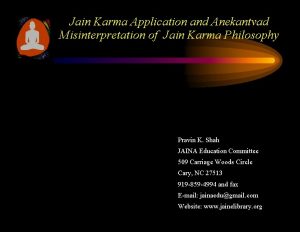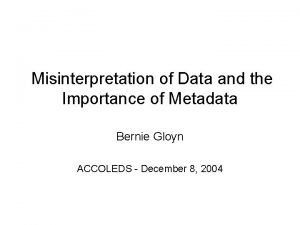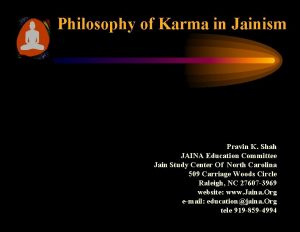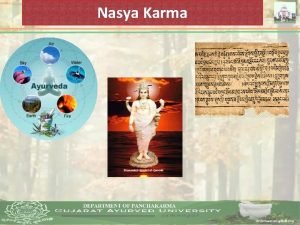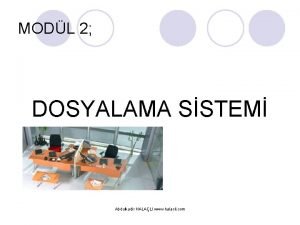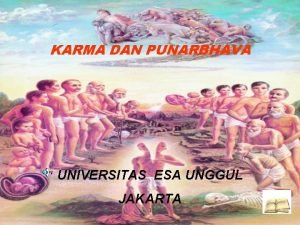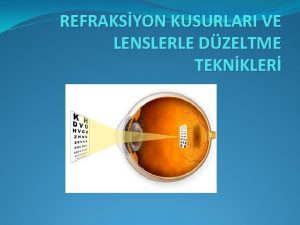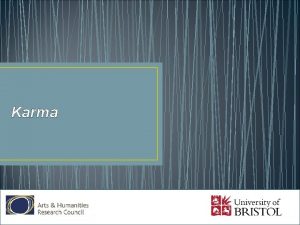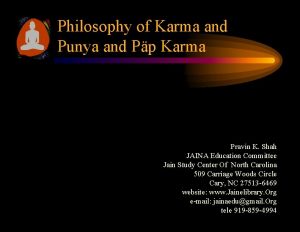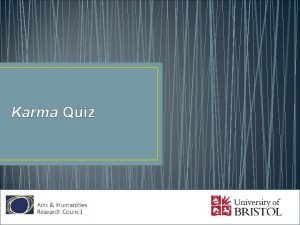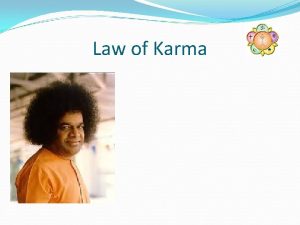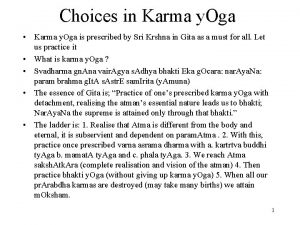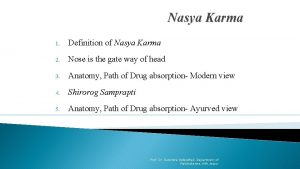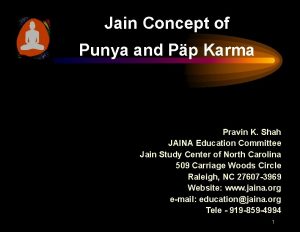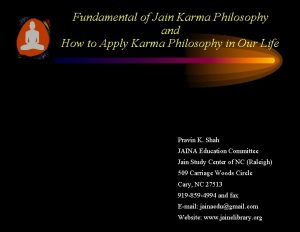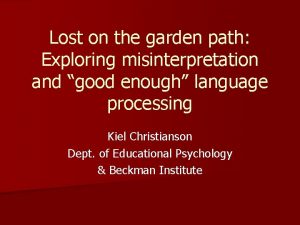Jain Karma Application and Anekantvad Misinterpretation of Jain




















- Slides: 20

Jain Karma Application and Anekantvad Misinterpretation of Jain Karma Philosophy Pravin K. Shah JAINA Education Committee 509 Carriage Woods Circle Cary, NC 27513 919 -859 -4994 and fax E-mail: jainaedu@gmail. com Website: www. jainelibrary. org

Fundamental Beliefs Jainism • Soul and Karma exist from Eternity • The Soul is in Mithyätva (False knowledge, not having true knowledge of reality, and wrong belief) from Eternity • Karma is attached to the Soul from Eternity • The Principles governing the successions of life cycles (Birth, Life, and Death) is Karma. • Our Ignorance (Mithyätva), Vices (Kashäya) and Intention behind our actions of body, mind, and speech continues to bind us with new Karma. • Ignorance (Mithyätva) is the root cause of all Sufferings • Ultimate goal of life is Liberation. Removal of Mithyätva and Kashaya in turn helps to removes all Karma.

Properties Karma is a matter (Pudgal) and hence it possesses all characteristics of matter • No consciousness / knowledge • Possesses Body • Occupies Space Very fine particles (smallest particle in the universe) Can not be seen/feel/verified Entire Universe is filled with Karma Particles

Effects of Karma. . ØKarma continuously produce their effect on to the Soul Ø It obscures the Soul's natural quality of Infinite Vision, Knowledge, Power, Conduct. Hence Soul possesses limited Vision or Faith, Knowledge, Power, Conduct, pleasure and pain (Ghäti Karma) Ø Soul with Karma also possesses Body (human, animal, insects etc), Life span, Social standing, healthy or unhealthy body and environment (Aghäti Karma) ØThe intensity of the effect of Karma depends on the illusion and ignorance of the Soul at that time ØOne person's Karma does not affect the other living being (no connection)

Dravya and Paryay Dravya (Substance) – Every substance in the universe continuously changes its form. During the modification process, its certain qualities or properties remains unchanged. Collectively the unchanged qualities are called as Dravya. Paryäya (Modification or Form) – Each substance in the universe continuously modifies its form. This form is called Paryay of that substance at that time. Dravya and Paryay are inseparable. – e. g. Bengal is a Paryay, Gold is a Dravya

Upadan and Nimitta Upädän (Real cause of the change or result) • Upädän is a real cause of a result • It is One and Only One in any given process, result, or activity Nimitta (Apparent cause of the change or result) • Nimitta is an apparent cause of a result or a catalytic agent (helper) of a process, result, or activity • There can be one or more Nimitta in any given event

Possible Reflections Reflection of person X 1. It was Y's bad karma that he got hurt. I was just the Nimitta 2. It was predestined for Y to get hurt 3. I was not driving carefully. Due to my negligence Y got hurt Reflection of person Y 1. It was my bad karma that I got hurt. Person X was just Nimitta 2. It was predestined for me to get hurt 3. It was X's fault. If he would have been careful I would not get hurt Reflection of person Z 1. Y got hurt because of his bad karma. Let him complete the suffering so that his karma get exhausted 2. It was predestined for Y to get hurt 3. Y got hurt and I should try my best to help him immediately

Jain Spiritual Understanding of Five Samavayi Causes Jain Reality (Logic) explains that Five Causes of equal magnitude (Samavayi) are always present when an event happens in the Universe or in our Life • Time (Kal) • Intrinsic nature (Swabhav) • Predestination (Niyati, Bhavitavyata, or Honahar) • Instrumental cause (Nimitta) – External Beings, Objects (External Cause) – Karma (Internal Cause) • Determination, Self-effort, or Freewill (Purushärtha)

Example • Leaves fall off at beginning of fall season, Winter is cold (Time) • Apple seeds grow apples not oranges, Female gets pregnant not male (Intrinsic Nature) • Animals can not do Meditation (Predestination) • Person X wins a lottery (Karma, Instrumental cause) • Gandhiji got the Independence of India (Free Will / Determination)

Example – X, Y, and Z Persons X and Y are involved in a car accident Person X was at fault Person Y got hurt Person Z witnessed the accident What are the possible reflections of persons X, Y, and Z. Note – X Y and Z have good knowledge of Jain principles and Karma philosophy

Ignorant Person's Reflection of person X It was Y's bad karma that he got hurt. I was just the Nimitta or I happened to be present. Reflection of person Y It was X's fault. If he would have been careful I would not get hurt. He is totally responsible for the accident. Reflection of person Z Y got hurt because of his bad karma. Let him complete the suffering so that his karma get exhausted

Spiritual Person's Reflection Reflects on one cause which enhances his spirituality or reduces his kashays such as anger, greed, ego, lust etc. X –It was my negligence (Freewill) Y –It was my bad Karma or my Predestination Z –My intrinsic nature (Swabhav) is Compassion. I need to help Y immediately

Fully Realized (Kevali) Person's Reflection Fully Realized (Kevali) person reflects that this is way the incident occurred (All 5 Causes are Present Equally).

Analysis Jain reality explains that 5 causes exist equally for any event that occurs in the Universe However 3 of 5 causes are beyond our control • Time, Intrinsic nature, Predestination Instrumental Cause (Nimitta) • To certain extent External circumstances are in our control • Karma which have not produced the result (which are in Satta) continuously changes with our reflection Freewill or Determination (Purusharth) is in our control

Summary Jain reality indicates that Five Causes are always present for any event that happens in the Universe. To form an opinion on any one of the five causes indicates our ignorance (Mithyatva) about Jain reality. However during our spiritual growth period, we should reflect on one cause that will reduce or minimize our vices (Kashaya) such as Anger, Ego, Deceit, and Greed and enhance our spirituality. Kevali visualizes the presence of all five causes at all the time. However his action will always be compassionate without any attachment to the action.

Summary. . During the action or activity period one should reflect on: One's own effort for the success (Determination, Free will, Self-effort) At the conclusion of an activity or action one should reflect on: If the result is positive The success was due to the help from others (external Nimitta or circumstances) If the result is negative The failure was due to • My past karma • Was Predestined • My effort was not adequate

Spiritual Understanding of Predestination Person needs Freewill, Determination, Effort or Ego to progress from Illusionary/Ignorant state (1 st Gunasthank) to Monkshood state (6 th Gunasthank) Person can not spiritually progress further without dissolving his/her ego. To the egoless person, all events that occur in the universe seems predestined • This does not mean that events are predestined in reality (all five causes are equally present) Only single concept of Predestination violates Jain theory of Five Samavayi Causes.

Keval Jnan The popular definition: • Kevali is capable of visualizing All Past, Present, and Future Events together of the universe (Paryaya of every substances) at the same time Analysis • From reflection (Upayog) point of view, Kevali's reflection remains within his/her soul all the time (He lives in present moment only). Hence Kevali never reflects in past and future time and on external objects • The definition is useful to get rid of ego (karta bhav) to further enhance our spirituality from 6 th Gunasthanak to 13 th Kevali stage.

Karma and Compassion Our ignorance or intention behind our actions of body, mind, and speech bind us with Karma. Hence during an ignorance state, a person is controlled by surroundings (Nimitta). • Hence on the path of spiritual progress, the ignorant person should be surrounded by proper environment –Religious study, and Swadhyay –Charity, Environmental and Social work –Temple and Pathshälä going, Tirth Yatra

Karma and Compassion. . . • As spiritual progress occurs, the effect of Nimitta reduces, and the power of Free-will (Upadan) increases • For a totally realized person (Kevali) surroundings (Nimitta) has no effect • Karma philosophy applies to myself only, Compassion applies to all
 Karma properties
Karma properties Promotion survey questions
Promotion survey questions Robert burns catcher in the rye
Robert burns catcher in the rye Moksha cycle
Moksha cycle Bhakti marga hinduism
Bhakti marga hinduism Karma in sikhism
Karma in sikhism Karma in jainism
Karma in jainism M�lakat sorular?
M�lakat sorular? Shirovirechana meaning
Shirovirechana meaning Coğrafi dosyalama sistemi
Coğrafi dosyalama sistemi La ley del karma
La ley del karma Karma yoga
Karma yoga Açımlayıcı sıralı karma yöntem
Açımlayıcı sıralı karma yöntem What is karma
What is karma Punabhava
Punabhava Mooie karma teksten
Mooie karma teksten Bsiz isim tam
Bsiz isim tam Optik transpoze
Optik transpoze Karma örgüt yapısı
Karma örgüt yapısı Sferosilindirik lensler
Sferosilindirik lensler Ethamsyl
Ethamsyl
